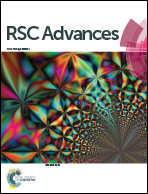Chloro-aluminium phthalocyanine loaded in ultradeformable liposomes for photobiology studies on human glioblastoma†
Abstract
Photodynamic therapy (PDT) has emerged as an alternative clinical protocol to treat brain tumors in early and advanced stages. PDT has provided promising results in both in vitro and in vivo (animal) studies. Phthalocyanines (Pcs), classified as second-generation photosensitizers (PSs), display advantageous photophysical properties and have been recognized as potential PSs for PDT. Because Pcs absorb strongly in the red region of the electromagnetic spectrum (670–780 nm), have low dark toxicity, efficiently generate ROS, and selectively target tumors in a well-designed drug delivery system (DDS), these photosensitizers have been applied for industrial, technological, and medical purposes. In this study, we have loaded chloroaluminum phthalocyanine (PcAlCl) in ultradeformable liposomes (UDLs) of soybean phosphatidylcholine containing different edge activators (Tween 80, Span 80, sodium desoxycholate) as a DDS. We have also compared the photo and physicochemical characteristics of these UDLs with the characteristics of classic and well-established conventional liposomes (CLs) currently used as DDS for different drugs in many pharmaceutical industries. The UDLs measured between 78 and 142 nm on average, presented zeta potentials between −6.1 and −39.9 mV, had encapsulation efficiencies ranging from 50.3 to 84.7%, and remained stable for 12 months. The elasticity of the UDLs resulted in two to four times higher stability as compared to CLs, a major advantage for pharmaceutical applications. The UDLs were not cytotoxic in dark conditions (IC50 > 2.0 μM); however, their viability decreased significantly 24 hours post-irradiation with any of the visible light doses used herein. The light dose that gave the best activity was 1 J cm−2. Compared to free PcAlCl, PcAlCl loaded on UDLs exhibited 72% higher activity toward the glioblastoma cell line U87MG (ID50 = 0.4 J cm−2) and the cell death mechanism was based on apoptosis. These data reinforced the idea that UDLs are an efficient DDS for PcAlCl during PDT treatment of brain cancer cells.


 Please wait while we load your content...
Please wait while we load your content...